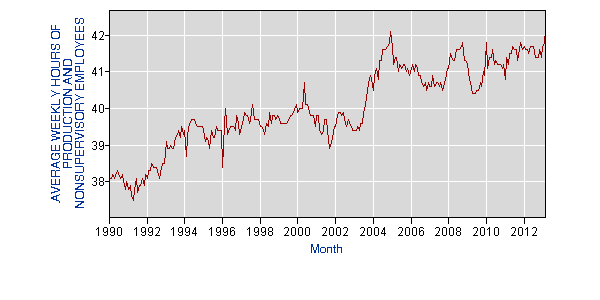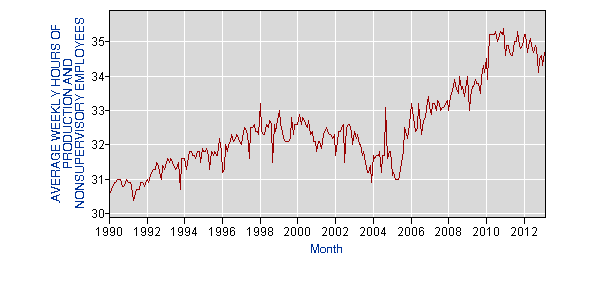May 08, 2013
Most coverage of the April jobs report celebrated the 165,000 new jobs reported for the month which was somewhat better than consensus predictions. Almost no one noticed the decline in the length of the average workweek. As a result of the fall in average hours, the April reduction in the index for total hours worked tied for the largest drop in the recovery.
Catherine Rampell does pick up on this point in a NYT Economix blog post today. Noting the decline, she raises the possibility that it is related to the Affordable Care Act, which requires firms that employ more than 50 full-time workers to either provide health insurance or to pay a penalty. Since the cutoff for a full-time worker in this provision is 30 hours per week, there would be an incentive to keep hours under this cutoff.
While Rampell expresses skepticism of this explanation, it probably deserves even less credence than she gives it. It is important to remember that this issue would only be relevant for firms that employ more than 50 workers and don’t currently provide health insurance for their workers. The overwhelming majority of firms that employ more than 50 workers already provide health insurance. Furthermore, most workers are employed at firms that employ fewer than 50 workers and are not close to this cutoff.
The share of the workforce that could plausibly be affected by this cutoff would almost certainly be well under 10 percent. This means that we would have to see very large movements in hours for this group of workers in order to move the overall average. Also, this issue just became relevant in 2013 which will provide the basis for the firms’ obligations when this provision of the ACA comes into effect next year. If the ACA is a big factor in the general trend in hours then we should be seeing a very different pattern in 2013 than we did in 2012. We don’t.
The post also notes two industries that seem to be bucking the trend toward shorter hours, trucking and temporary employment. The pattern in these industries toward longer hours is striking, but it is worth noting that it is not new. Both industries have seen an upward trend in hours for more than two decades. (The figures show data for production workers rather than all workers. This group accounts for more than 80 percent of employment. Data for all workers is only available back to 2006.)
Truck Transportation

Temporary Employment

Source: Bureau of Labor Statistics.
As can be seen, while both industries (especially trucking) show some cyclical variation, there is a clear upward trend in both sectors over this whole period. This means that developments in the economy in the last five years are probably not responsible for the recent rise in hours in these sectors.
Note: In comments DV tells us that the FT was on the job last Friday. Rex Nutting at MarketWatch also.







Comments